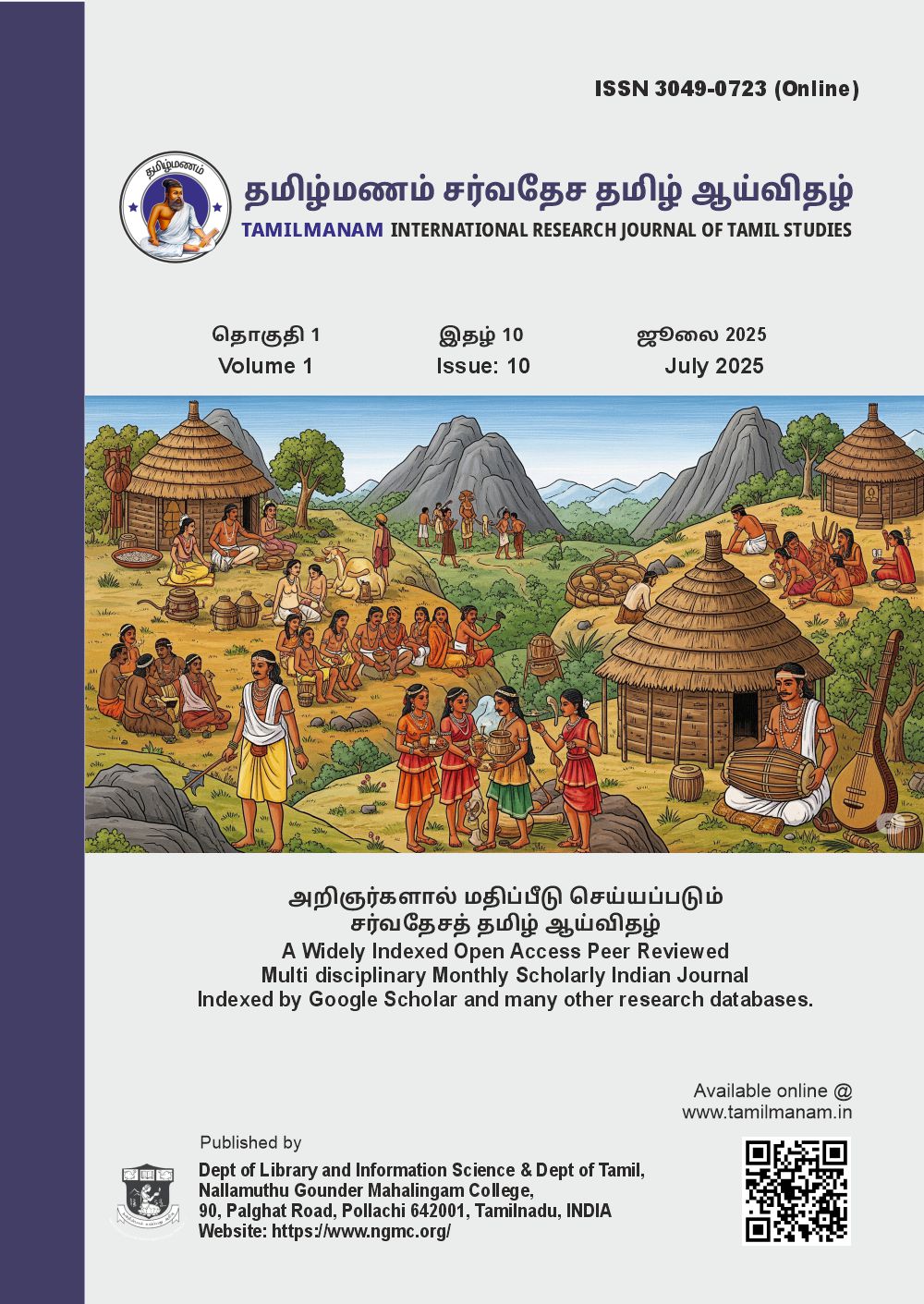Lifestyle of Parathaiyar as Shown by Kalittokai
கலித்தொகை காட்டும் பரத்தையர் வாழ்வியல்
DOI:
https://doi.org/10.63300/tm0110202507Keywords:
Parathaiyar, discrimination, Love, Lifestyle, MotherhoodAbstract
The ancient grammar and literature of the Tamil language mention the main characters in the Aga life of the people as Thalaivan, Thalaivi, and Dozhi. In this, Parathaiyar is the one who has the same characteristics as Thalaivi. The incidents about Parathaiyar have been mentioned by Tolkappiyar in the Kalaviyal. As drama characters, one of the five dynasties of Marutha, in the epic poems of Sangam literature, the events of Parathaiyar's life are recorded as the reason for the conflict between Thalaivan and Thalaivi. There are records about Parathaiyar in Thirukkural. Agapporul Vilakkam very clearly explains on what basis Parathaiyar is divided. Thus, Parathaiyar is notable among the egoists mentioned in grammar and literature. Parathaitar is the one who is often credited with the rights to the Marutha. This article is based on the lifestyle of Prathaiyar found in the Kalittokai Maruthakali songs to illustrate the qualities and virtues of Parathaiyar.
தமிழ்மொழியின் பண்டைய இலக்கண, இலக்கியங்கள் கூறும் மக்களின் அக வாழ்க்கையில் முதன்மையானவர்கள் தலைவன், தலைவி, தோழி ஆவர். இதில் தலைவிக்கு நிகரான பண்புடையவராகத் திகழ்பவர் பரத்தையர் ஆவர். பரத்தையர் பற்றிய நிகழ்வுக் கூற்றுகளைத் தொல்காப்பியர் களவியலில் குறிப்பிட்டுள்ளார். நாடகப் பாத்திரங்களாக, ஐந்திணைகளில் ஒன்றான மருத நிலத்தில் தலைவிக்கும் தலைவனுக்கும் இடையில் பிரிவு தோன்றுவதற்குக் காரணமாகப் பரத்தையரின் வாழ்க்கை நிகழ்வுகள் சங்க அகப்பாடல்களில் பதிவு செய்யப்பட்டுள்ளன. திருக்குறளில், பரத்தையர் பற்றிய பதிவுகள் உள்ளன. அகப்பொருள் விளக்கம் பரத்தையர் எத்தகைய தன்மை அடிப்படையில் பிரிக்கப்பட்டுள்ளார் என்று மிகவும் தெளிவாக விளக்குகின்றது. இதனால் இலக்கண, இலக்கியங்கள் எடுத்துக்கூறும் அக மாந்தர்களுள் குறிப்பிடத்தக்கவர், மருதத்திற்கே பெரும்பாலும் உரிமை பூண்டு விளங்குபவர் பரத்தையர் எனலாம். கலித்தொகை மருதக்கலிப் பாடல்களில் காணப்படும் பரத்தையர் உறவுப் பாடல்களை அடிப்படையாகக் கொண்டு பரத்தையரின் பண்பு நலங்களை, வாழ்வியலை எடுத்துக்கூறுவதாக இக்கட்டுரை அமைந்துள்ளது.
Downloads
References
1. Ilampooran (Ed.), (1973) Tolkappiyam Bhattathikaram, Saiva Siddhanta Nulapadippukakkagam, Tirunelveli
2. Gloria Sundaramathi, E., (1973) Sangam Literature Marutham, University of Kerala, Kerala
3. Subramanian, N., (2017) Sangam Life, New Century Book House, Chennai
4. Dakshinamoorthy, A., (2013) Tamil Civilization and Culture, Manivasagar Publishing House, Chennai.
5. Thirugnanasambantham, S., (Ed.)(2019) Content Description, Kathir Publishing House, Thiruvaiyaru.
6. Devaraj, M. (ed.), (2005) Parathaiyar Malai, Department of Tamil Literature, University of Madras, Chennai.
1. இளம்பூரணர்(உ.ஆ.),(1973) தொல்காப்பியம் பொருளதிகாரம், சைவ சித்தாந்த நூற்பதிப்புக்கழகம், திருநெல்வேலி
2. குளோரியா சுந்தரமதி,இலா.,(1973) சங்க இலக்கியம் மருதம், கேரளாப் பல்கலைக்கழகம், கேரளா
3. சுப்ரமண்யன்,ந.,(2017)சங்ககால வாழ்வியல்,நியூ செஞ்சுரி புக் ஹவுஸ்,சென்னை
4. தட்சிணாமூர்த்தி,அ.,(2013) தமிழர் நாகரிமும் பண்பாடும், மணிவாசகர் பதிப்பகம், சென்னை.
5. திருஞானசம்பந்தம்,ச.,(உ.ஆ.)(2019) அகப்பொருள் விளக்கம், கதிர் பதிப்பகம், திருவையாறு.
6. தேவராஜ்,மு.(பதிப்பு),(2005) பரத்தையர் மாலை, தமிழ் இலக்கியத்துறை, சென்னைப் பல்கலைக்கழகம்,சென்னை.
Downloads
Published
Issue
Section
License
Copyright (c) 2025 Dr. R. PRIYADHARSHINI (Author)

This work is licensed under a Creative Commons Attribution 4.0 International License.
Our journal adopts CC BY License Creative Commons Attribution 4.0 International License http://Creativecommons.org//license/by/4.0/ . It allows using, reusing, distributing and reproducing of the original work with proper citation.






